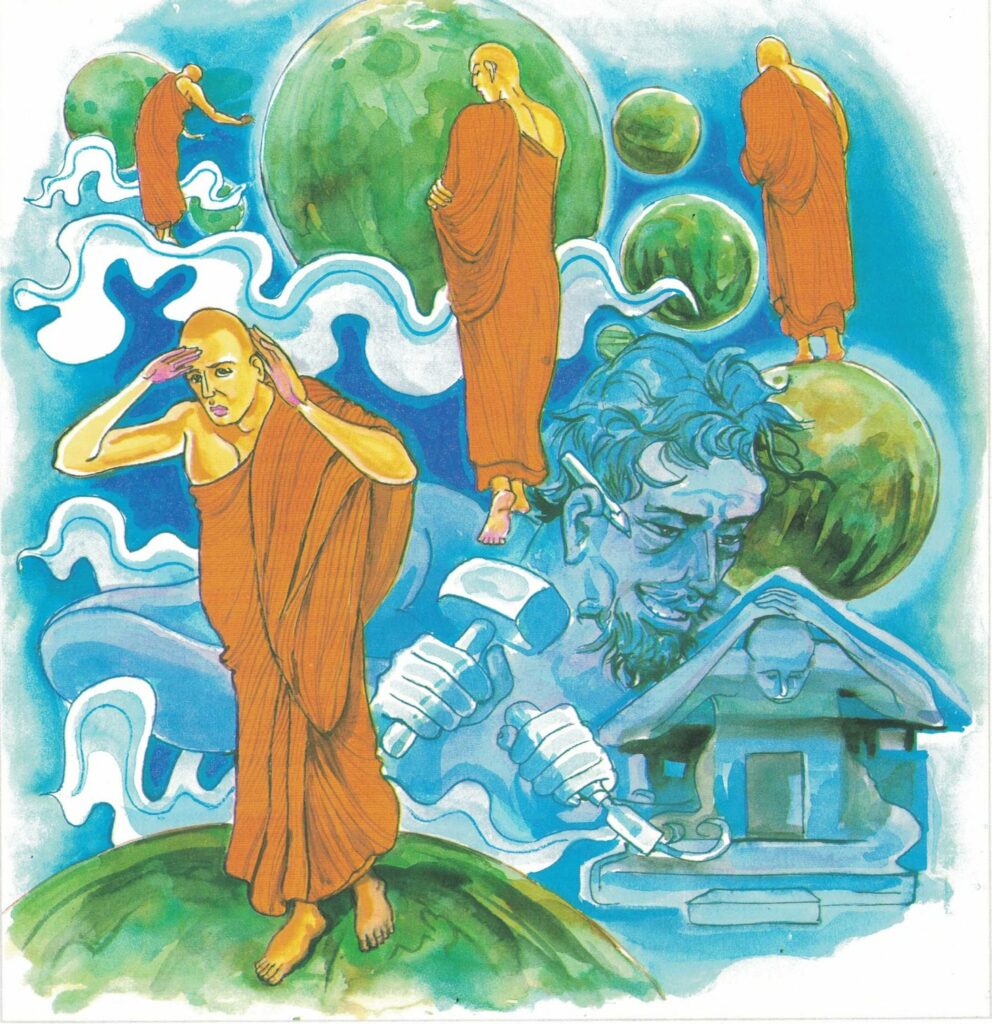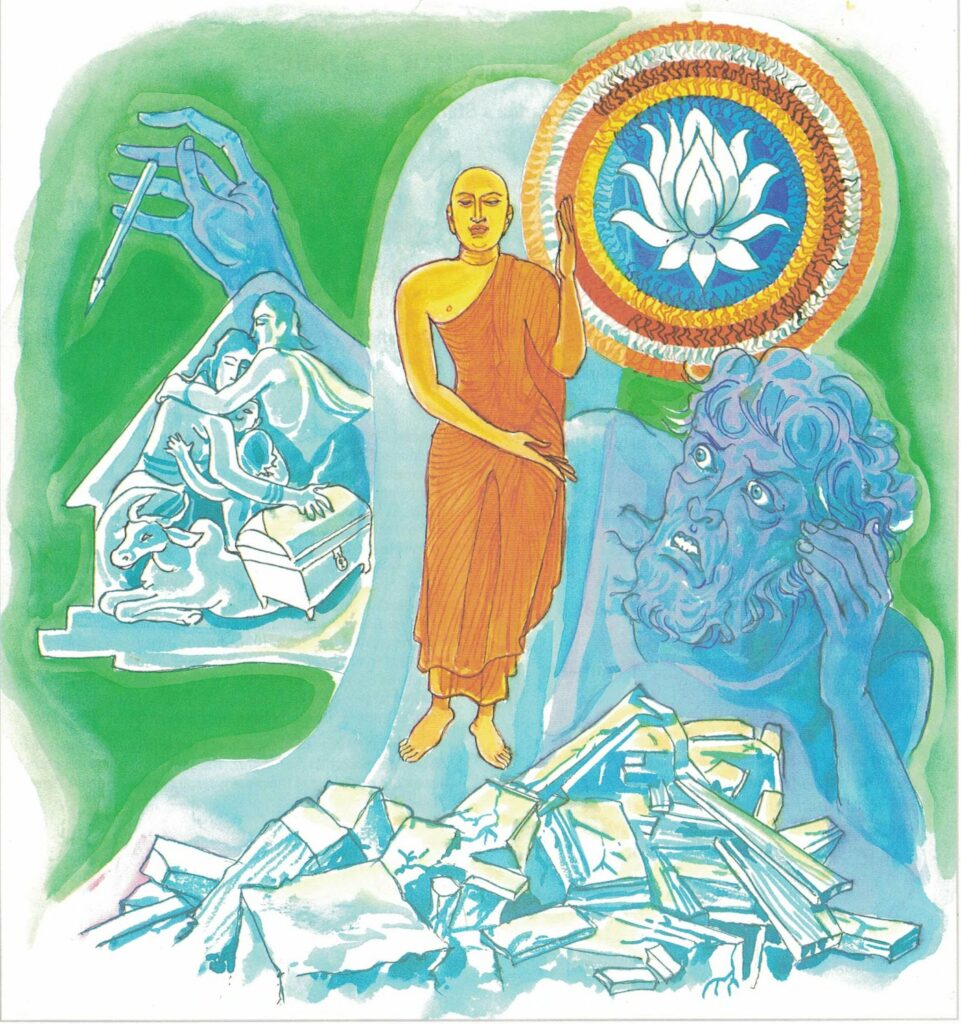Pali text, illustration and English translation of Dhammapada verse 153-154:
anekajāti saṃsāraṃ sandhāvissaṃ anibbisaṃ |
gahakārakaṃ gavesanto dukkhā jāti punappunaṃ || 153 ||
gahakāraka diṭṭho’si puna gehaṃ na kāhasi |
sabbā te phāsukā bhaggā gahakauṭaṃ visaṅkhitaṃ |
visaṅkhāragataṃ cittaṃ taṇhānaṃ khayam’ajjhagā || 154 ||
153. Through many of saṃsāra’s births I hastened seeking, finding not the builder of this house: pain is birth again, again.
154. O builder of this house you’re seen, you shall not build a house again, all your beams have given way, rafters of the ridge decayed, mind to the Unconditioned gone, exhaustion of craving has it reached.


Venerable Ānanda’s Stanzas
This religious instruction was spoken by the Buddha while he sat at the foot of the Bodhi-tree (Tree of Enlightenment) by way of solemn speech (Udāna) and at a later time was recited to Venerable Ānanda in answer to a question.
For the Buddha, sitting at the foot of the Bodhi-tree, before the setting of sun, had overcome the force of Māra; in the first watch, drove away the darkness that veils previous states of existence; in the middle watch, acquired supernatural vision; and in the last watch, out of pity for living beings, by focussing his thoughts on dependent originations and meditating on it both forwards and backwards, at sunrise he obtained complete enlightenment. Thereupon, he breathed forth a solemn declaration common to countless number of Buddhas.
Explanatory Translation (Verse 153)
punappunaṃ jāti dukkhā gahakārakaṃ gavesanto
anekajāti saṃsaraṃ anibbisaṃ sandhāvissaṃ
punappunaṃ [punappuna]: over and over, repeatedly; jāti: birth; dukkhā: is sorrow fraught; gahakārakaṃ [gahakāraka]: (so) the house builder; gavesanto [gavesanta]: seeking; anekajāti saṃsaraṃ [saṃsara]: numerous births in this seemingly endless cycle of existence; anibbisaṃ [anibbisa]: without encountering; sandhāvissaṃ [sandhāvissa]: travelled
This tour, this cycle of existence, has run through numerous births without encountering, looking for the builder, the creator of the world and self. For repeated birth is painful.
Explanatory Translation (Verse 154)
gahakāraka diṭṭho asi. puna gehaṃ na kāhasi
te sabbā phāsukā bhaggā gahakūtaṃ visaṅkhitaṃ
cittaṃ visaṅkhāragataṃ. tanhānaṃ khayaṃ ajjhagā
gahakāraka: you house builder; diṭṭho asi: I have seen you; puna: once again; gehaṃ [geha]: the house; na kāhasi: will not build; te: your; sabbā phāsukā: all supports; bhaggā: (are) destroyed; gahakūtaṃ [gahakūta]: the structure of the house; visaṅkhitaṃ [visaṅkhita]: (is) demolished; cittaṃ [citta]: mind; visaṅkhāragataṃ [visaṅkhāragata]: has stopped being conditioned; tanhānaṃ khayaṃ [khaya]: the cessation of the urge; ajjhagā: has been achieved
O, you builder, the creator, you are at last seen. You will never build this house and self again. All your supports are destroyed; the structure is demolished. The mind has stopped being conditioned, the urge has ceased.
Commentary and exegetical material (Verse 153-154)
Special Note. At dawn, on the very day of His Enlightenment, the Buddha spoke this paean of joy (Udāna) which vividly describes His transcendental moral victory and His inner spiritual experience. He was compelled to travel on this tour (saṃsāra) and consequently to suffer, as He could not discover the architect that built this house and the self. In His final birth, while engaged in solitary meditation, which He had highly developed, in the course of His wanderings, after a relentless search He discovered, by His own insight, the elusive architect residing, not outside, but within the recesses of His own heart. It was the mental process of perception and conception (sankhāra) and the compulsive urge to exist (bhava tanhā) that was the creator, the architect, the builder, which is a mental process latent in all. What is created by oneself can be destroyed by oneself. The discovery of the architect is the introspective awareness of the mental process, which stopped the process, attaining arahatship. In these verses it is alluded to as ‘the cessation of the urge’.
The support of this self-created house is the urge. The structure is the mental construct (sankhāra). The shattering of the structure by becoming conscious of the process results in the complete demolition of the house.
With the demolition of the house the mind attains the unconditioned state, which is Nibbāna. Here, the Buddha admits his past wanderings in existence which entail suffering, a fact which evidently proves that rebirth, more than being a mere belief, is the very factual basis of the practice of Buddhism. It is the problem that the Buddha set out to solve for the benefit of all mankind.
tanhānaṃ khayaṃ ajjhagā: literally attained the cessation of the craving which is Nibbāna the deathless.
Nibbāna is the summum bonum of Buddhism.
The Jātaka Commentary relates that the Bodhisatta, in his birth as the ascetic Sumedha, contemplated thus:
“Even as, although Misery is,
Yet Happiness is also found,
So, though indeed Existence is,
Non-existence should be sought.“Even as, although there may be Heat,
Yet grateful Cold is also found,
So, though the three-fold Fire exists,
Likewise Nirvāna should be sought.“Even as, although there Evil is,
That which is Good is also found,
So, though ‘tis true that birth exists.
That which is not birth should be sought.”
The pāli word Nibbāna (Sanskrit–Nirvāna) is composed of ‘N’ and ‘Vāna’. N is a negative particle. Vāna means motion. “It is called Nibbāna in that it is the absence (Ni) of that compulsive urge to move, which is the reaction of an organism to stimulation which is called Vāna.” As long as one is impelled by the urge, one accumulates fresh Kammic activities which must continue in one form or other the perpetual cycle of birth and death. When all forms of this urge are eradicated, reproductive kammic forces cease to operate, and one attains Nibbāna, stopping the cycle of birth and death. The Buddhist conception of deliverance is stopping the ever-recurring cycle of life and death.
Nibbāna is also explained as the extinction of the fetters of lust (lobha), hatred (dosa), and delusion (moha). “The whole world is in flames,” says the Buddha. “By what fire is it kindled? By the fire of lust, hatred and delusion; by the fire of birth, old age, death, sorrow, lamentation, pain, grief and despair is it kindled.” Nibbāna, in one sense may be interpreted as the extinction of these flames. Nibbāna is nothing but the extinction of these flames. The extinction of the flames is not the means of attaining Nibbāna, it is the end itself.
Some writers hesitate to say that Nibbāna is nothingness. They forget the all important concept of ‘nothingness’ (suññatā) in Buddhism. They always crave for something even in Nibbāna. But unless we ‘desire nothing’ we cannot attain Nibbāna. If Nibbāna is nothingness, then it must be analogous to space (Ākāsa). Both space and Nibbāna are eternal and unchanging. The former is eternal because it is the absence of matter. The latter is both spaceless and timeless. It is incorrect to say that space or Nibbāna ‘is not’. It may briefly be said that space ‘is’ in relation to matter; and Nibbāna ‘is’ in relation to suffering.
The Buddha, speaking of the different planes of existence, makes special reference to a ‘Realm of Nothingness’ (Ākiñcaññāyatana), which must be distinguished from Nibbāna. The realm of nothingness is not an absence but a perception of nothingness.
In this image Buddha describes the self as a house built by a housebuilder. The house-builder, identifies in these verses in craving (taṇhā). The reason for such an identification is that in the system of Buddha’s right. The factor that brings about repeated birth in the cycle of existence in craving.